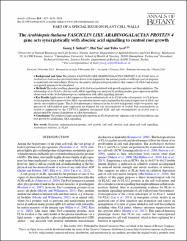The Arabidopsis thaliana FASCICLIN LIKE ARABINOGALACTAN PROTEIN 4 gene acts synergistically with abscisic acid signalling to control root growth
Access
Attribution 3.0 United Statesinfo:eu-repo/semantics/openAccesshttp://creativecommons.org/licenses/by/3.0/us/Date
2014Access
Attribution 3.0 United Statesinfo:eu-repo/semantics/openAccesshttp://creativecommons.org/licenses/by/3.0/us/Metadata
Show full item recordAbstract
Background and Aims The putative FASCICLIN-LIKE ARABINOGALACTAN PROTEIN 4 (At-FLA4) locus of Arabidopsis thaliana has previously been shown to be required for the normal growth of wild-type roots in response to moderately elevated salinity. However, the genetic and physiological pathway that connects At-FLA4 and normal root growth remains to be elucidated. Methods The radial swelling phenotype of At-fla4 was modulated with growth regulators and their inhibitors. The relationship of At-FLA4 to abscisic acid (ABA) signalling was analysed by probing marker gene expression and the observation of the At-fla4 phenotype in combination with ABA signalling mutants. KeyResults Application of ABA suppresses the non-redundant role of At-FLA4 in the salt response. At-FLA4 positively regulates the response to low ABA concentration in roots and is required for the normal expression of ABA- and abiotic stress-induced genes. The At-fla4 phenotype is enhanced in the At-abi4 background, while two genetic suppressors of ABA-induced gene expression are required for salt oversensitivity of At-fla4. Salt oversensitivity in At-fla4 is suppressed by the CYP707A inhibitor abscinazole E2B, and salt oversensitivity in At-fla4 roots is phenocopied by chemical inhibition of ABA biosynthesis. Conclusions The predicted lipid-anchored glycoprotein At-FLA4 positively regulates cell wall biosynthesis and root growth by modulating ABA signalling.
Volume
114Issue
6Collections
The following license files are associated with this item:



















